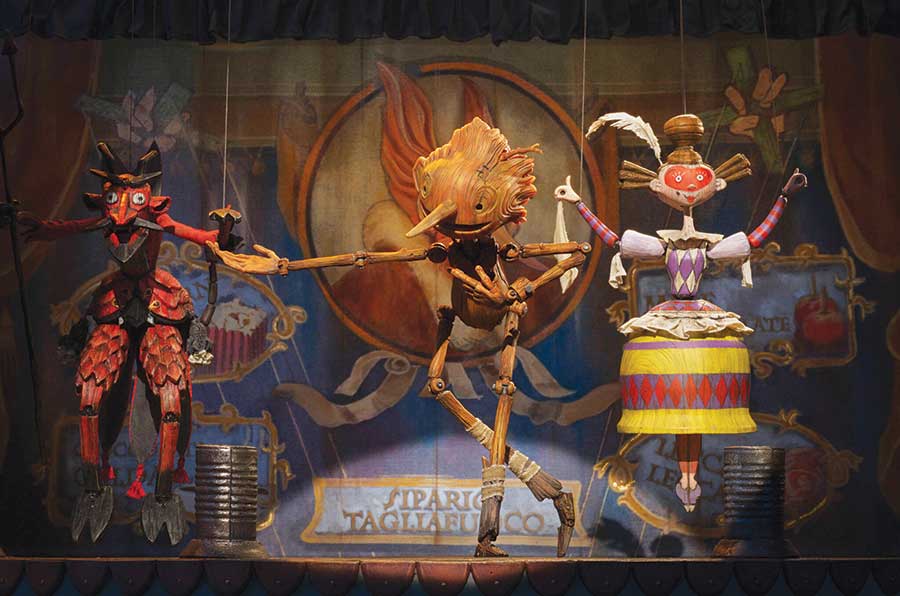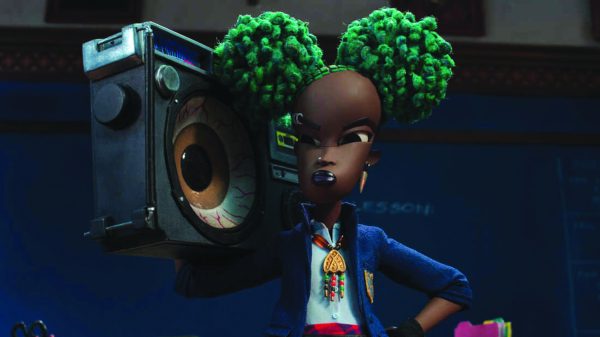Farts, poop and Mussolini too
Director Guillermo Del Toro is well known for his fantastical storytelling, making the auteur’s stop-motion macabre reimagining of the 1883 novel “The Adventures of Pinocchio” an artistic standout of the three Pinocchio adaptations released last year.
With the help of co-director Mark Gustafson, three simultaneous production teams in London, Portland, and Guadalahara were spearheaded by animation studio ShadowMachine, well known for their work on risqué Emmy winning series “Robot Chicken” and fellow Emmy winner “Bojack Horseman.”
ShadowMachine may seem like an interesting choice considering their previous work’s mature tone, which contrasts greatly with Pinocchio’s most famous adaptation by Disney, but Del Toro’s vision takes a more poignant exploration of love, trauma, and grief than any previous adaptation, which these artists skillfully bring to life.
The story focuses on mourning woodworker Geppetto, voiced by David Bradley (best known for his surly portrayal of Hogwarts caretaker Argus Filch), who drunkenly carves the titular puppet in the visage of his dead son Carlo, as he’s forced into the role of reluctant caretaker to the spirited wooden boy.
Unlike his predecessors, this Pinocchio’s story is one that doesn’t directly focus on his flaws or naivete. Del Toro stresses that this Pinocchio changes everyone around him because he’s so pure, a sentiment clear in the script but one that’s enhanced by young Gregory Mann’s performance, which evokes the innocent and self-assured manner of a child untouched by the emotional trauma and social pressures of his fellows who live in the fascist-era Italian setting.
Mann’s singing for example, with its small mistakes and squeaks, conjures the image of a real child rather than a seasoned singer, making his performance of “Ciao Papa” particularly heart-wrenching.
Diegetic musical sequences like this are featured sparingly in composer Alexandre Desplat’s score, which features a pointed use of woodwinds that accompany Del Toro and the team’s visuals nicely. The score immerses us further into the film’s atmosphere, which Desplat himself oddly describes as having a joyous melancholy. The success of this collaboration isn’t particularly surprising considering their previous work together, namely 2017’s “The Shape of Water” (which also made me cry).
Bradley and Mann are accompanied by a robust cast of performers as both reinvented and film original characters, including Ewan McGregor as Sebastian J. Cricket. (Who could go wrong casting Obi Wan?) McGregor’s take on the pintsize mentor is often mocked for his grandiose and outwardly self-important affect, but it’s also his passion that makes him so lovable and fun to watch.
Christoph Waltz appears as the circus’ conniving Count Volpe and Cate Blanchet in a surprising turn as Spazzatura the monkey, both of whom shine and convince in their roles, but particularly Blanchet ,who manages to communicate impressively considering Spazzatura never actually speaks. We also hear longtime collaborator Ron Perlman (who worked with Del Toro on “Hellboy” and “Blade II”) as the Podesta and “Stranger Things” Finn Wolfhard as his son Candlewick, a family associated with the fascist government.
Del Toro’s choice of historical setting is not a surprising one, as grappling with fascism has always been a recurring theme in his works from “The Devil’s Backbone” to “Pan’s Labyrinth” to even his Hellboy adaptations. Though some might initially perceive these politics as distracting or simply incidental, they absolutely serve to enhance the story (on top of being an important reminder). The Podesta, named only for his position of authority (as Podesta is a civil office title specific to the time period) and who serves as complementary villain to the circus’s Count Volpe, provides an important foil to Geppetto and Pinocchio’s relationship in how he treats his own son, which is cruelly, with a touch of toxic masculinity.
Geppetto’s journey to becoming a kinder and more loving father through his grief is contrasted greatly by the Podesta’s stubborn authoritarian morality. Count Volpe serves as an extension of this more overt fascism, exploiting it and Pinocchio for his own monetary gain by having him perform propaganda songs and marches, sequences which are both whimsical and horrible, making it all the more satisfying when Pinocchio finally transforms them into a song about poop and farts for very special guest, Benito Mussolini.
Due to the nature of stop-motion, filming itself took nearly two years to complete and pre-film production took about 15. Individually photographed frames must be taken as the puppets, set pieces, and props are moved ever so slightly by animators. These frames are run through a software for motion smoothing called Dragonframe, which recently has been able to facilitate multiple exposure lighting techniques pioneered for the film by director of photography Frank Passingham. (Keep an eye on any water or fire in the film to see the impressive results of these labors.)
The individual puppets can take up to a year to sculpt and fabricate before they can go out on stage and Del Toro himself recalled in Netflix’s behind the scenes documentary that one particular shot even took three months by itself. Each set, costume, and prop, each individual button being painted is painstakingly crafted. All this time and careful attention helps create a visually cohesive and realized world that invokes reality with deliberate puppeteering and subtle expression-making. These characters feel like living, thinking beings.
This careful planning also went into Del Toro’s penchant for creature design, which is on full display in this adaption’s whale-equivalent, the monstrous and grotesquely fun Dogfish. We’re also treated to rabbit-like afterlife inhabitants and Death herself, realized as a sphynx-like ethereal creature and voiced by the similarly ethereal Tilda Swinton. Even Pinocchio is given this “Del Toro” treatment, his half-carved look evoking a Frankenstein-like quality that further distances him from his peers, otherness being another recurring theme in Del Toro’s works.
The culmination of these qualities is a world that feels fanciful, at times even outlandish, but still grounded in the universal humanness of pain, growth, and unconditional love. This movie made me cry the first and second time I watched it and I highly recommend watching the behind-the-scenes documentary as well, “Handcarved Cinema,” for an even better look at the love and care that went into the making of this film. Both are available on Netflix. An artistic feat by all involved, Del Toro’s “Pinocchio” is almost sure to move you, if not merely impress through its phenomenal craftsmanship.










